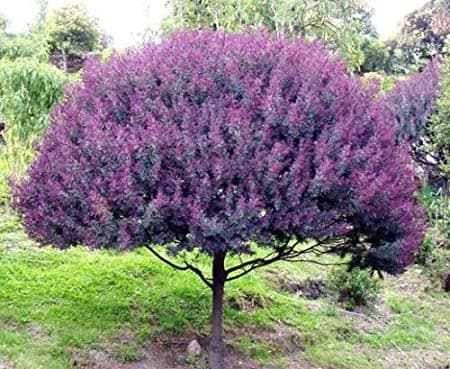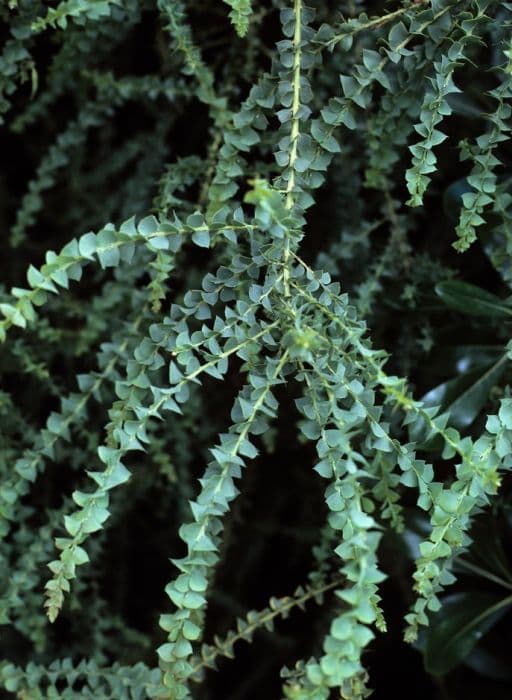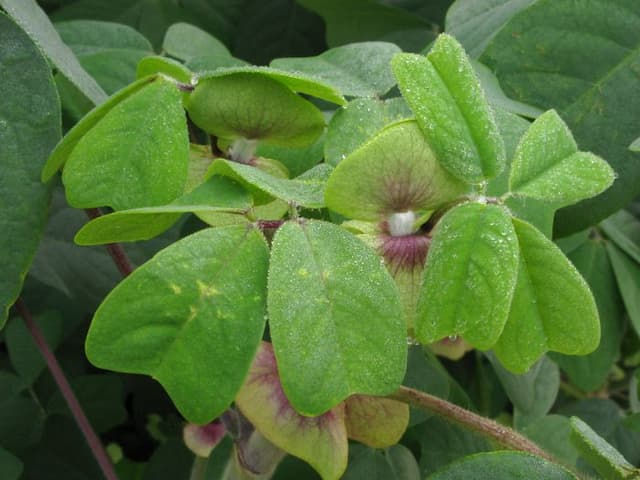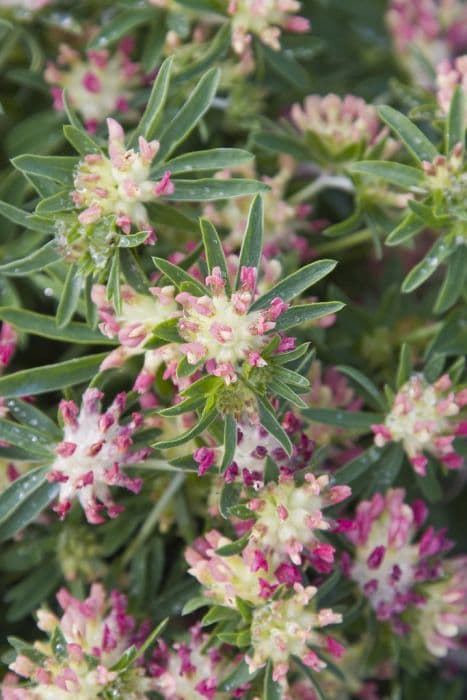Dyer's Greenweed Genista tinctoria 'Royal Gold'

ABOUT
Royal Gold is an ornamental shrub that showcases an impressive display of vibrant yellow flowers that tend to blanket the branches. The rich golden hues of the blossoms are particularly eye-catching and can brighten up any garden setting. The flowers are small and pea-shaped, forming dense clusters along the stems, which contributes to the spectacular visual impact when the shrub is in full bloom. The foliage of Royal Gold consists of small, green leaves that are narrow and pointed, resembling the typical foliage of many plants in the pea family. The leaves are arranged in a way that creates a fine-textured appearance, providing a perfect backdrop to the brilliant yellow flowers. This foliage often turns to shades of yellow or gold in the fall, which adds another layer of seasonal interest to the plant. Its stems are slender and can give the shrub an upright to spreading form, depending upon how it is grown and pruned. The overall appearance is of a dense, bushy plant that is well-suited for use in garden beds and borders, where its showy display can really stand out. When not in bloom, Royal Gold remains a plant of interest due to its textured foliage and general structure, making it a versatile and attractive addition to a landscape for multiple seasons. Overall, Royal Gold has an appearance that exudes cheerfulness and brightness, surely becoming a focal point wherever it is planted.
About this plant
 Names
NamesFamily
Fabaceae.
Synonyms
Dyer's Greenweed, Dyer's Broom, Woadwaxen, Waxen Wood, Greenweed.
Common names
Cytisus tinctorius, Genistella tinctoria, Genista patula.
 Toxicity
ToxicityTo humans
Dyer's greenweed is known to contain toxic compounds that can be harmful if ingested. These compounds can cause various symptoms when parts of the plant are eaten, including nausea, vomiting, diarrhea, and abdominal pain. In severe cases, the toxicity can lead to more serious health issues such as muscle weakness and changes in heart rhythm, which could be potentially life-threatening without prompt medical treatment.
To pets
Dyer's greenweed can be toxic to pets if they ingest any part of the plant. The symptoms of poisoning in pets can include vomiting, diarrhea, lethargy, and weakness. More severe toxicity can cause issues such as tremors, seizures, and heart problems. It's important to prevent pets from ingesting this plant and to seek veterinary care immediately if poisoning is suspected.
 Characteristics
CharacteristicsLife cycle
Perennials
Foliage type
Deciduous
Color of leaves
Green
Flower color
Yellow
Height
2 feet (0.61 meters)
Spread
2 feet (0.61 meters)
Plant type
Shrub
Hardiness zones
5
Native area
Europe
Benefits
 General Benefits
General Benefits- Attracts Pollinators: Dyer's Greenweed is a nectar-rich plant that attracts bees, butterflies, and other beneficial insects to the garden, promoting pollination of nearby plants.
- Low Maintenance: This hardy shrub requires minimal care once established, making it ideal for gardeners looking for low-maintenance landscaping options.
- Drought Tolerant: Once established, Dyer's Greenweed has good drought tolerance, reducing the need for frequent watering and making it suitable for xeriscaping.
- Fast Growing: It's a fast-growing plant that fills in areas quickly, providing a rapid display of color and coverage.
- Deer Resistant: The plant is generally not preferred by deer, making it a good choice for areas where deer browsing is a problem.
- Erosion Control: With its sturdy growth habit, Dyer's Greenweed can help stabilize soil and control erosion on slopes and banks.
- Ornamental Qualities: With vibrant yellow flowers and a neat, bushy form, this plant adds aesthetic value to gardens and landscapes.
- Cultural Significance: It has a historical use in dye production, which can be of interest to those passionate about traditional crafts or botanical history.
- Habitat Support: Provides shelter and food for wildlife, contributing to the overall health of the ecosystem.
 Medical Properties
Medical Properties- Diuretic: The plant has been traditionally used to promote urine production and relieve fluid retention.
- Astringent: Genista tinctoria has compounds that may help to tighten and tone tissues, which can be beneficial in treating wounds and cuts.
- Laxative: Historically, it has been used to relieve constipation and support bowel movements.
- Emmenagogue: It is believed to stimulate menstrual flow and has been used in traditional medicine to address menstrual irregularities.
 Air-purifying Qualities
Air-purifying QualitiesThis plant is not specifically known for air purifying qualities.
 Other Uses
Other Uses- Genista tinctoria 'Royal Gold', commonly known as Dyer's Greenweed, has traditionally been used in fabric dyeing, providing a range of yellows and greens depending on the mordant used.
- The stems of Dyer's Greenweed were historically used for basket weaving due to their flexibility and strength.
- In some cultures, Dyer's Greenweed was burned during ceremonies for the pleasant fragrance it releases, contributing to a calming atmosphere.
- The plant can be used as a natural barrier in landscapes because of its dense growth habit, helping in creating borders or hedges in garden designs.
- Gardeners can use this plant in conjunction with others to create a habitat for attracting and supporting beneficial insects like bees and butterflies.
- Dyer's Greenweed can be used in natural landscaping to prevent soil erosion on slopes or banks thanks to its root system that holds soil in place.
- This plant may be included in naturalistic planting schemes to restore wild areas with its ability to thrive in poor soils and support the local ecosystem.
- Its tough stems have been used to make small handcrafted items such as brooms or rudimentary tools in the past.
- The bright yellow flowers of Dyer's Greenweed can serve as a natural dye for wool, leather, or even paper, creating vibrant hues in arts and crafts.
- In rural traditions, the branches of Dyer's Greenweed were used to light hearths as they are easily flammable and served well for kindling.
Interesting Facts
 Feng Shui
Feng ShuiThe plant Genista is not used in Feng Shui practice.
 Zodiac Sign Compitability
Zodiac Sign CompitabilityThe plant Genista is not used in astrology practice.
 Plant Symbolism
Plant Symbolism- Protection: Often used to ward off negative energies, Genista tinctoria 'Royal Gold', also known as Dyer's Greenweed, is associated with protection.
- Preparation: Dyer's Greenweed has a history of use in dyeing, symbolizing readiness and the preparation for change or transformation.
- Purity: With its vibrant yellow flowers, Dyer's Greenweed is often linked with purity and cleansing, as yellow can represent light and purification.
 Water
WaterThe Dyer's Greenweed should be watered deeply and thoroughly, allowing the soil to dry out slightly between watering sessions. This typically means providing the plant with about 1 inch of water once a week, but you should adjust the frequency depending on weather conditions and soil type. In hot, dry periods, you might need to water twice a week, while in cooler, wetter weather, less frequent watering is necessary. Avoid overhead watering to keep the foliage dry and prevent disease, focusing the water at the soil level instead.
 Light
LightDyer's Greenweed thrives in full sun, preferring at least six hours of direct sunlight each day. The best spot for this plant is in an area of the garden where it can receive ample sunlight throughout the day without being shaded by larger plants or structures.
 Temperature
TemperatureDyer's Greenweed does well in a range of temperatures and is hardy in USDA zones 5 through 8. The ideal temperature range for the plant is between 60°F and 75°F. It can tolerate temperatures down to about -20°F in winter and high summer temperatures as long as it is not in extreme and prolonged heat.
 Pruning
PruningPrune Dyer's Greenweed in late winter or early spring to remove dead or damaged branches and to shape the plant. Pruning encourages new growth and can help maintain a dense, attractive form. It's not necessary to prune annually, but occasional trimming helps keep the plant vibrant and may enhance blooming.
 Cleaning
CleaningAs needed
 Soil
SoilDyers Greenweed prefers well-drained soil enhanced with organic matter, thriving in a pH range from slightly acidic to neutral (pH 5.5 to 7.0). A mix of garden soil, peat, and sharp sand can provide the drainage and nutrients it needs.
 Repotting
RepottingDyers Greenweed, being a hardy shrub, does not need frequent repotting. It can be repotted every 2-3 years or when it has outgrown its current container, ensuring minimal root disturbance.
 Humidity & Misting
Humidity & MistingDyers Greenweed is adaptable to a range of humidity conditions and does not require specific humidity levels, as it is tolerant of the humidity levels typically found in its outdoor environment.
 Suitable locations
Suitable locationsIndoor
Ensure bright light, cool temperate; minimal indoor growing.
Outdoor
Plant in sun, well-drained soil; hardy and drought tolerant.
Hardiness zone
5-8 USDA
 Life cycle
Life cycleGenista tinctoria 'Royal Gold', commonly known as 'Royal Gold' broom, begins its life as a seed, which upon germination, develops a root system and shoots that emerge from the soil. The plant then enters a vegetative stage, growing leaves and stems, and once mature enough it will produce its distinctive yellow pea-like flowers in late spring to early summer. After pollination, typically by insects, the flowers produce small pods that contain seeds. These seeds are eventually dispersed, possibly by wind or animals, to begin a new generation. In the fall, the plant prepares for dormancy by shedding its leaves and entering a rest period through winter months. With the return of favorable conditions in spring, 'Royal Gold' resumes growth, completing its annual cycle.
 Propogation
PropogationPropogation time
Early Spring
Propogation: The most popular method of propagating the Dyer's Greenweed is through semi-hardwood cuttings. This is typically done in late summer after the shrub has flowered. Cuttings should be around 4 to 6 inches (10 to 15 centimeters) long and have several nodes. The lower leaves are stripped off and the cut end is dipped in rooting hormone to facilitate root development. These prepared cuttings are then placed in a well-draining soil mix, ensuring at least one node is buried beneath the soil surface. The soil should be kept consistently moist, but not waterlogged, and the cuttings should be placed in indirect light until roots have developed, after which they can be transplanted.









